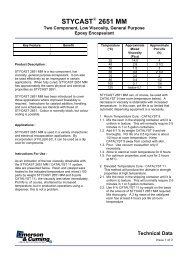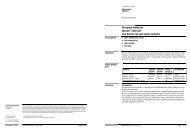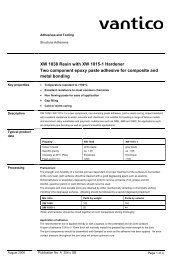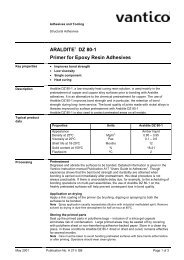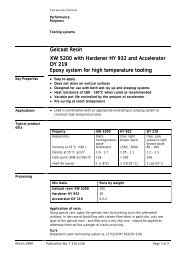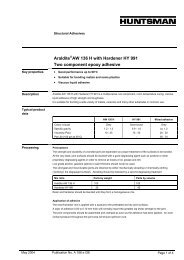XD 4510 / XD 4511 Temperature resistant two component epoxy ...
XD 4510 / XD 4511 Temperature resistant two component epoxy ...
XD 4510 / XD 4511 Temperature resistant two component epoxy ...
Create successful ePaper yourself
Turn your PDF publications into a flip-book with our unique Google optimized e-Paper software.
Structural Adhesives<strong>XD</strong> <strong>4510</strong> / <strong>XD</strong> <strong>4511</strong><strong>Temperature</strong> <strong>resistant</strong> <strong>two</strong> <strong>component</strong> <strong>epoxy</strong> pasteadhesiveKey properties • <strong>Temperature</strong> <strong>resistant</strong> to 180°C• Excellent resistance to most common chemicals• Non-flowing paste for ease of application and good gap filling• Bonds a wide range of substrate materials• Post cure recommended for optimum propertiesDescription <strong>XD</strong> <strong>4510</strong> with <strong>XD</strong> <strong>4511</strong> is a <strong>two</strong> <strong>component</strong>, ambient temperature gelling paste adhesive, which after post curingat temperatures up to 150°C, will give bonds with temperature resistance up to 180°C and excellent resistance tocommon chemicals. It is suitable for bonding a range of ferrous metals and aluminium alloy substrates andcomposite materials such as GRE, GRP and SMC.Typical productdataProperty <strong>XD</strong> <strong>4510</strong> <strong>XD</strong> <strong>4511</strong> Mixed adhesiveColour (visual) White-beige paste Black paste Dark grey pasteViscosity at 25°C (Pas) 90 - 140 50 - 70 80 - 140Specific gravity 1.55 - 1.65 1.55 - 1.65 1.55 - 1.65Pot Life (100 gm at 25°C) - - 90 minutesProcessing PretreatmentThe strength and durability of a bonded joint are dependant on proper treatment of the surfaces to be bonded.At the very least, joint surfaces should be cleaned with a good degreasing agent such as acetone, iso-propanol(for plastics) or other proprietary degreasing agents in order to remove all traces of oil, grease and dirt.Low grade alcohol, gasoline (petrol) or paint thinners should never be used.The strongest and most durable joints are obtained by either mechanically abrading or chemically etching(“pickling”) the degreased surfaces. Abrading should be followed by a second degreasing treatmentMix ratio Parts by weight Parts by volume<strong>XD</strong> <strong>4510</strong> 100 100<strong>XD</strong> <strong>4511</strong> 50 50The resin and hardener should be mixed together at room temperature stirring thoroughly.Application of adhesiveThe resin/hardener mix is applied directly or with a spatula, to the pretreated and dry joint surfaces.A layer of adhesive 0.05 to 0.10mm thick will normally impart the greatest lap shear strength to the joint.The joint <strong>component</strong>s should be assembled and clamped as soon as the adhesive has been applied. An evencontact pressure throughout the joint area will ensure optimum cure.May 2004 Publication No. A 393 f GB Page 1 of 4
Mechanical processingSpecialist firms have developed metering, mixing and spreading equipment that enables the bulk processing ofadhesive.We will be pleased to advise customers on the choice of equipment for their particular needs.Equipment maintenanceAll tools should be cleaned with hot water and soap before adhesives residues have had time to cure. Theremoval of cured residues is a difficult and time-consuming operation.If solvents such as acetone are used for cleaning, operatives should take the appropriate precautions and, inaddition, avoid skin and eye contact.Curing requirementsTo achieve optimum performance properties an elevated temperature cure or post cure is recommended. Thisadhesive will solidify to a handlable state but will not fully cure at temperatures below 60°C.Suggested cure schedules are:3 hrs1 hr30 minsat 80°Cat 130°Cat 150°CTypical curedpropertiesUnless otherwise stated, the figures given below were all determined by testing standard specimens made bylap-jointing 170 x 25 x 1.5 mm strips of aluminium alloy. The joint area was 12.5 x 25 mm in each case.The figures were determined with typical production batches using standard testing methods. They are providedsolely as technical information and do not constitute a product specification.Average lap shear strengths of typical metal-to-metal joints (ISO 4587)Cure: 24 hours at 23°C + 1hour at 130°C and tested at 23°CPretreatment - Sand blastingAluminium alloySteel 37/11Stainless steel V4AGalvanised steelCopper/Brass0 2 4 6 8 10 12 14 16 18Average lap shear strengths of typical plastic to plastic joints (ISO 4587)Cured: 24 hours at 23°C + 1hour at 130°C and tested at 23°CPretreatment - Lightly abrade and isopropanol degreasePolycarbonateN/mm 2N/mm 2ABSSMC0 5 10May 2004 Publication No. A 393 f GB Page 2 of 4
Lap shear strength versus temperature (ISO 4587) (typical average values)Cure: (a)=24 hours at 23°C + 1hour at 130°C (ACB, shot blast),(b)= 30 mins at 100°C (L165, pickled)N/mm 2242016ba1284°C0-60 -40 -20 0 20 40 60 80 100 120 140 160 180 200Roller peel test (ISO 4578)Substrate: Aluminium alloy 1.6N/mm tested at 23°CCure: 24hours at 23°C + 1hour at 130°C 6.0 N/mm tested at 120°CLap shear strength versus immersion in various media for 90 days (ISO 4587)Typical average valuesCure: 24hours at 23°C + 1 hour at 130°C and tested at 23°CAs-made valueAcetoneGasoline (petrol)Ethyl acetateAcetic acid, 10%MethanolLubricating oilSulphuric acid 10%111-trichloroethaneWater at 20°CWater at 90°CTropical weathering*N/mm 20 5 10 15 20* DIN 50015 (40/92)May 2004 Publication No. A 393 f GB Page 3 of 4
Storage <strong>XD</strong> <strong>4510</strong> and <strong>XD</strong> <strong>4511</strong> may be stored for up to 3 years at room temperature, provided that storage is in originalsealed containers. The expiry date is indicated on the label.HandlingprecautionsCautionOur products are generally quite harmless to handle provided that certain precautions normally taken whenhandling chemicals are observed. The uncured materials must not, for instance, be allowed to come into contactwith foodstuffs or food utensils, and measures should be taken to prevent the uncured materials from coming incontact with the skin, since people with particularly sensitive skin may be affected. The wearing of imperviousrubber or plastic gloves will normally be necessary; likewise the use of eye protection. The skin should bethoroughly cleansed at the end of each working period by washing with soap and warm water. The use ofsolvents is to be avoided. Disposable paper - not cloth towels - should be used to dry the skin. Adequateventilation of the working area is recommended. These precautions are described in greater detail in theMaterial Safety Data sheets for the individual products and should be referred to for fuller information.Huntsman AdvancedMaterialsAll recommendations for the use of our products, whether given by us in writing, verbally, or to be implied from the results oftests carried out by us, are based on the current state of our knowledge. Notwithstanding any such recommendations the Buyershall remain responsible for satisfying himself that the products as supplied by us are suitable for his intended process orpurpose. Since we cannot control the application, use or processing of the products, we cannot accept responsibility therefor.The Buyer shall ensure that the intended use of the products will not infringe any third party’s intellectual property rights. Wewarrant that our products are free from defects in accordance with and subject to our general conditions of supply.Duxford, Cambridge EnglandCB2 4QA© Huntsman Advanced Materials (Switzerland) GmbH® Araldite is a registered trademark of Huntsman LLC or an affiliate thereof in one or more, but not all, countries.Tel: +44 (0) 1223 832121Fax: +44 (0) 1223 493322www.araldite.comMay 2004 Publication No. A 393 f GB Page 4 of 4


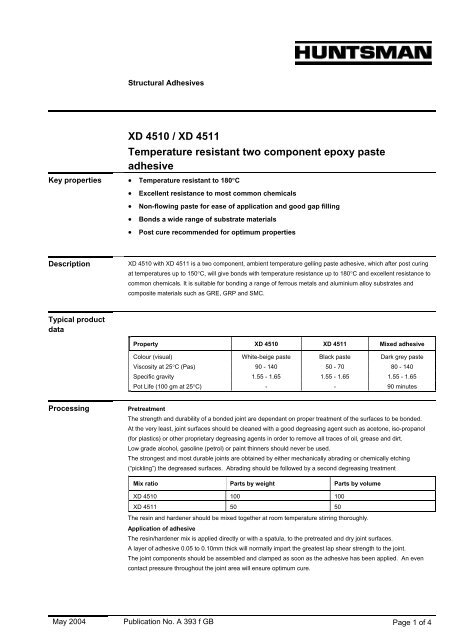
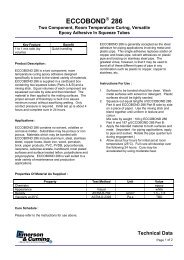
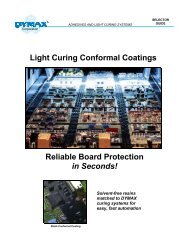

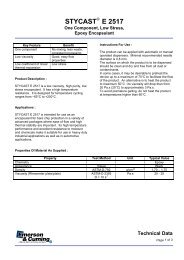
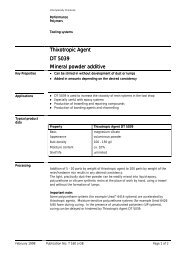
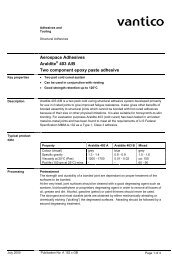
![[pdf] EXXON-TF56-TD - Lindberg & Lund AS](https://img.yumpu.com/52492677/1/190x245/pdf-exxon-tf56-td-lindberg-lund-as.jpg?quality=85)
